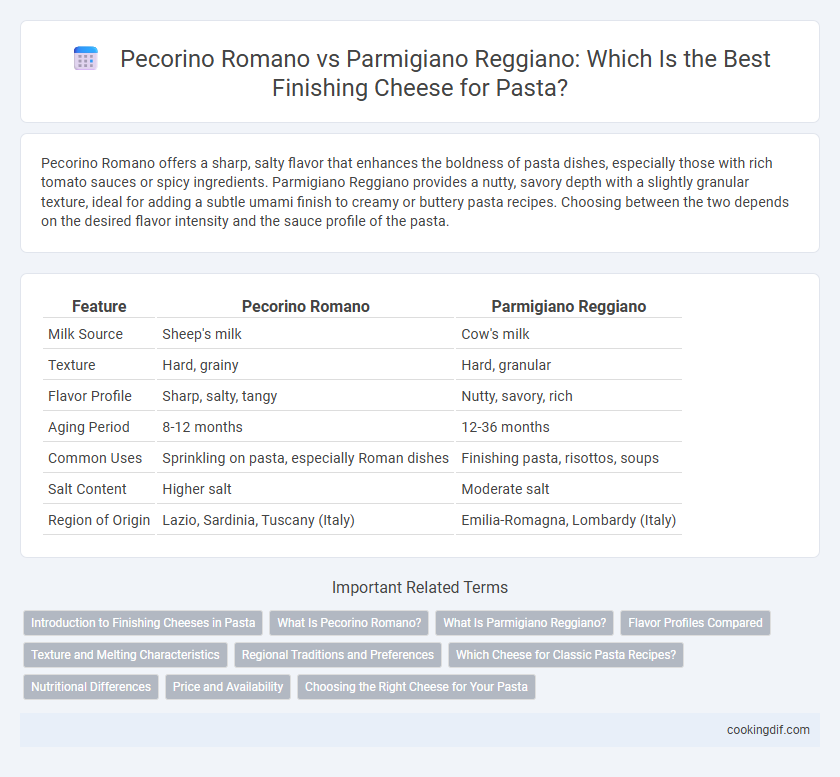Pecorino Romano offers a sharp, salty flavor that enhances the boldness of pasta dishes, especially those with rich tomato sauces or spicy ingredients. Parmigiano Reggiano provides a nutty, savory depth with a slightly granular texture, ideal for adding a subtle umami finish to creamy or buttery pasta recipes. Choosing between the two depends on the desired flavor intensity and the sauce profile of the pasta.
Table of Comparison
| Feature | Pecorino Romano | Parmigiano Reggiano |
|---|---|---|
| Milk Source | Sheep's milk | Cow's milk |
| Texture | Hard, grainy | Hard, granular |
| Flavor Profile | Sharp, salty, tangy | Nutty, savory, rich |
| Aging Period | 8-12 months | 12-36 months |
| Common Uses | Sprinkling on pasta, especially Roman dishes | Finishing pasta, risottos, soups |
| Salt Content | Higher salt | Moderate salt |
| Region of Origin | Lazio, Sardinia, Tuscany (Italy) | Emilia-Romagna, Lombardy (Italy) |
Introduction to Finishing Cheeses in Pasta
Pecorino Romano offers a sharp, salty flavor with a crumbly texture, ideal for bold pasta dishes like Cacio e Pepe. Parmigiano Reggiano provides a nutty, savory profile and granular texture, enhancing subtle pasta sauces such as Alfredo or Carbonara. Choosing between the two depends on the desired intensity and complexity of the pasta's finishing touch.
What Is Pecorino Romano?
Pecorino Romano is a hard, salty Italian cheese made from 100% sheep's milk, renowned for its sharp, tangy flavor that enhances pasta dishes. Unlike Parmigiano Reggiano, which is made from cow's milk and offers a nutty, savory profile, Pecorino Romano delivers a bolder, more robust taste ideal for adding a distinctive finishing touch. This cheese's crumbly texture and intense saltiness make it a preferred choice for traditional Roman recipes like Cacio e Pepe and Carbonara.
What Is Parmigiano Reggiano?
Parmigiano Reggiano, often called the "King of Cheeses," is a hard Italian cheese made from cow's milk, aged for a minimum of 12 months, which develops a complex, nutty flavor ideal for grating over pasta dishes. Unlike Pecorino Romano, which is made from sheep's milk and has a sharper, saltier profile, Parmigiano Reggiano offers a balanced umami richness perfect for enhancing the texture and taste without overpowering the dish. Its granular texture and rich taste complement a variety of pasta sauces, making it a versatile finishing cheese in traditional Italian cuisine.
Flavor Profiles Compared
Pecorino Romano offers a bold, salty flavor with sharp, tangy notes derived from sheep's milk, making it ideal for adding a robust and savory kick to pasta dishes. Parmigiano Reggiano provides a nuttier, more complex taste profile with subtle umami and buttery undertones that blend seamlessly into creamy sauces. Both cheeses enhance pasta but serve distinct flavor purposes: Pecorino Romano intensifies sharpness while Parmigiano Reggiano enriches depth and richness.
Texture and Melting Characteristics
Pecorino Romano offers a crumbly, granular texture that softens but does not fully melt when heated, lending a sharp, salty flavor to pasta dishes. Parmigiano Reggiano features a hard, crystalline texture that melts more smoothly, creating a creamy finish ideal for enhancing sauces and toppings. The denser, oilier composition of Parmigiano Reggiano allows for better meltability, while Pecorino Romano retains its granular texture, providing distinct mouthfeel contrasts in finished pasta.
Regional Traditions and Preferences
Pecorino Romano originates from Lazio, Sardinia, and Tuscany, prized for its sharp, salty flavor that complements robust pasta dishes like Cacio e Pepe, reflecting Roman culinary traditions. Parmigiano Reggiano, hailing from Emilia-Romagna and Lombardy, offers a nutty, umami-rich profile favored in Northern Italian cuisine, often grated over pastas such as tagliatelle al ragu. Regional preferences are deeply rooted in local cheese production, with Pecorino Romano preferred in central Italy for its sheep's milk intensity, while Parmigiano Reggiano's cow's milk richness dominates northern pasta finishing.
Which Cheese for Classic Pasta Recipes?
Pecorino Romano offers a sharper, saltier flavor ideal for robust pasta dishes like Cacio e Pepe and Amatriciana, enhancing the boldness of classic Roman recipes. Parmigiano Reggiano provides a nuttier, more complex profile with a granular texture, perfect for delicate pasta such as Fettuccine Alfredo and Carbonara, balancing richness without overpowering. Choosing between Pecorino Romano and Parmigiano Reggiano depends on the pasta sauce's intensity and regional authenticity, ensuring the finishing cheese complements rather than dominates the flavors.
Nutritional Differences
Pecorino Romano contains higher sodium levels and more fat than Parmigiano Reggiano, making it a saltier and richer finishing cheese option. Parmigiano Reggiano offers greater protein content and more calcium per serving, supporting bone health and muscle repair. Both cheeses are rich in vitamins A and B12 but differ in their aging processes, influencing their nutrient density and flavor profiles.
Price and Availability
Pecorino Romano is generally more affordable than Parmigiano Reggiano, making it a budget-friendly choice for pasta finishing cheese. Parmigiano Reggiano tends to have wider availability in supermarkets and specialty stores globally due to its popularity and PDO status. Both cheeses offer distinct flavors, but Pecorino Romano's robust, salty profile complements cost-conscious recipes.
Choosing the Right Cheese for Your Pasta
Pecorino Romano offers a bold, salty flavor with a crumbly texture ideal for robust pasta dishes like Cacio e Pepe, while Parmigiano Reggiano provides a nutty, savory richness that enhances creamy sauces and traditional Italian recipes such as Carbonara. Selecting Pecorino Romano is best for sharp, tangy profiles that cut through hearty ingredients, whereas Parmigiano Reggiano's complex umami complements delicate flavors and adds depth to any pasta finish. Understanding the distinct aging processes and milk sources--sheep's milk for Pecorino Romano and cow's milk for Parmigiano Reggiano--helps tailor the perfect cheese pairing to elevate your pasta experience.
Pecorino Romano vs Parmigiano Reggiano for finishing cheese Infographic

 cookingdif.com
cookingdif.com